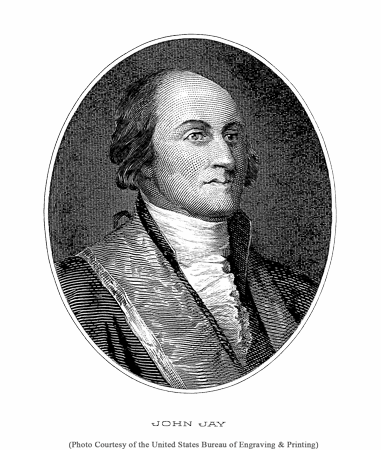
John Jay lived from 1745 to 1829. He served in numerous capacities during the American Revolution and the early years of the new country, and heads the list of Chief Justices of the Supreme Court of the United States.
Early Life and The Continental Congress
Jay grew up in a somewhat wealthy family and was admitted to the New York bar in 1768. He opened his own practice three years later and became a delegate to the First Continental Congress in 1774.
Following the approval of the Articles of Confederation after the war, Jay joined Alexander Hamilton in pushing for a stronger government in The Federalist Papers. He was later offered the position of Secretary of State by George Washington. After declining, he was approved as the first Chief Justice of the U.S. Supreme Court.
The Supreme Court
During Jay’s time as head of the Supreme Court, he heard four cases. The most influential of the group was Chisholm v Georgia, in which the court agreed with two South Carolina residents who claimed their land had been seized by the state of Georgia.
Even though the actual ruling of the law was quickly overturned by the Eleventh Amendment, which upheld each state’s rights, the precedent of judicial review had been set.
The Jay Treaty
While he was still head of the Supreme Court, Jay was chosen as a messenger to England to negotiate a treaty between the two countries, which were locked in a tense disagreement over trade routes and other matters.
The treaty was denounced by some when it was brought back to the U.S., but was ratified by the Senate in a close vote.
Governor of New York
When he returned from England in 1795, Jay learned that he had been elected Governor of New York in his absence. He had previously run for the post unsuccessfully in 1792.
He resigned from the Supreme Court and served as governor of his home state for six years. During that time he successfully passed a bill which gradually outlawed slavery in the state.
He was re-nominated for the Supreme Court in 1800 by President John Adams and confirmed by the Senate. However, he later chose to decline the nomination. Jay also unsuccessfully ran for President in 1796 and 1800, and later retired in 1801. He passed away in 1829 due to palsy.
Legacy
John Jay’s legacy is very present in the modern era, in reflection of his contributions to the start of the country.
The City University of New York officially named one of its colleges the John Jay College of Criminal Justice. His name is also found in many towns and high schools across the country, as well as mountains in Alaska and Vermont.








